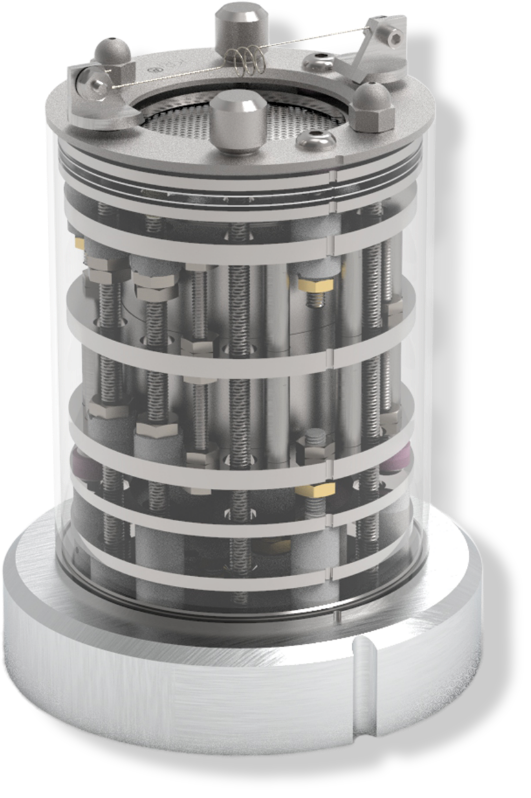Who We Are
Kaufman & Robinson (KRI®) is a pioneer and leader in the manufacture of broad-beam products, including commercial ion sources, plasma sources, and power supply controllers. From our state-of-the-art facility in Fort Collins, Colorado, we provide advanced solutions to high-tech industrialists, vacuum system OEMs, and research institutions around the world.
With a legacy of achievement in our field, a wealth of scientific talent today, and a vibrant culture of innovation, KRI® continues to invent the next generation of products.
Since the introduction of the Kaufman ion source, we have produced numerous broad beam designs, including gridded and gridless source technology, as well as switched-mode power supplies. The unique capabilities in these products have enabled better performance and material processes, as well as enhanced reliability.

Superior Technology, Exceptional Service
All KRI® products are produced by hand by our staff, from start to finish. This includes putting the product together piece by piece, testing and checking for quality, packaging and loading products for shipping, and literally signing off on the product’s completion.
When you receive your KRI® product, you will see the name of the person who created it. And if you have questions about your product, you can speak with that person directly.
From company founders to present-day staff, our team has made significant contributions to broad-beam technology and is recognized as a leader in our field. We have been awarded many patents, and we frequently contribute to the body of knowledge in our industry, with KRI® team members having authored over 100 articles, publications, books, and technical papers.
From company founders to present-day staff, our team has made significant contributions to broad-beam technology and is recognized as a leader in our field. We have been awarded many patents, and we frequently contribute to the body of knowledge in our industry, with KRI® team members having authored over 100 articles, publications, books, and technical papers.
From company founders to present-day staff, our team has made significant contributions to broad-beam technology and is recognized as a leader in our field. We have been awarded many patents, and we frequently contribute to the body of knowledge in our industry, with KRI® team members having authored over 100 articles, publications, books, and technical papers.
Superior Products Enabling Atomic-Level Control
Companies depend on KRI® technology when high-purity material processing is the objective. Implemented in vacuum environments, it is used in the deposition of thin films and etching of surfaces.
Our products enable the fabrication of structures with critical dimensions ranging from the micrometer to sub nanometer scale. Capable of extremely high precision, these products are engaged in creating materials and surface features.
The Kaufman Source
Through the years the Kaufman ion source has enabled vacuum process engineers and scientists to leverage ion-beam processing of materials in a variety of ways. For example, adoption of the Kaufman source has led to many breakthroughs that are now commonly understood benefits of advanced material processing, including →
The Kaufman Source
Through the years the Kaufman ion source has enabled vacuum process engineers and scientists to leverage ion-beam processing of materials in a variety of ways. For example, adoption of the Kaufman source has led to many breakthroughs that are now commonly understood benefits of advanced material processing, including ↓
In simple terms, a Kaufman ion source operates as follows:
In simple terms, a Kaufman ion source operates as follows:
Our History
Breaking New Ground in Broad Beam Sources
Dr. Harold Kaufman
Dr. Harold Kaufman formed Kaufman & Robinson, Inc., to continue his work after retiring from Colorado State University – where he had earned his Ph.D. in 1971 – on the faculty in the Physics and Mechanical Engineering departments and where he served as chair of the Physics Department from 1978 until his retirement.
But prior to this, Dr. Kaufman joined the NACA Lewis Research Center, which became a part of the new NASA space agency in 1957 and is now NASA Glenn. His research and work at NASA led to development of the electronic bombardment thruster (Kaufman thruster), had him leading the Ion Physics Branch and as assistant chief to the Electromagnetic Propulsion Division.
Dr. Harold Kaufman was inducted into the NASA Glenn Research Center Hall of Fame in 2016. NASA recognized the KRI® founder as a trailblazer of ion propulsion. This fitting tribute noted that Dr. Kaufman had “the rare distinction of inventing an experimental spaceflight hardware system that has not only been demonstrated in testing but is being flown in space today.”
Dr. Harold Kaufman
Dr. Harold Kaufman formed Kaufman & Robinson, Inc., to continue his work after retiring from Colorado State University – where he had earned his Ph.D. in 1971 – on the faculty in the Physics and Mechanical Engineering departments and where he served as chair of the Physics Department from 1978 until his retirement.
But prior to this, Dr. Kaufman joined the NACA Lewis Research Center, which became a part of the new NASA space agency in 1957 and is now NASA Glenn. His research and work at NASA led to development of the electronic bombardment thruster (Kaufman thruster), had him leading the Ion Physics Branch and as assistant chief to the Electromagnetic Propulsion Division.
Dr. Harold Kaufman was inducted into the NASA Glenn Research Center Hall of Fame in 2016.
NASA recognized the KRI® founder as a trailblazer of ion propulsion. This fitting tribute noted that Dr. Kaufman had “the rare distinction of inventing an experimental spaceflight hardware system that has not only been demonstrated in testing but is being flown in space today.”


